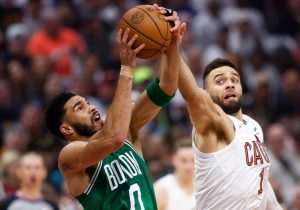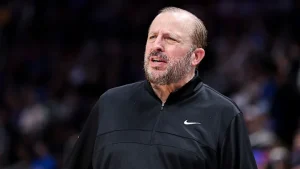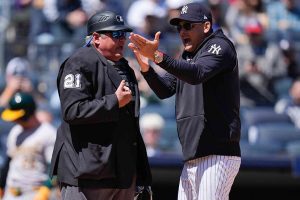
Anyone who has been following the Boston Celtics since October understands their potential for championship contention—or at least, that’s the expectation.
However, with Friday’s victory, Boston solidified its position among the unofficial contenders for the title. Securing their 40th win of the season, they became the first team this season to meet Phil Jackson’s “40-before-20” benchmark.
Jackson, arguably one of the greatest coaching figures in basketball history, boasts an illustrious career with 13 championships combined as a coach and player. In 2008, during the Lakers’ resurgence led by the Kobe Bryant and Pau Gasol duo, Jackson introduced his theory.
“You must win 40 games before you lose 20 to be seen as an elite team,” Jackson asserted.
It sounds straightforward enough. The notion that teams should maintain a 56-win pace to be considered genuine championship contenders hardly qualifies as groundbreaking news.
However, it’s a valuable practice—with a proven track record—that helps separate the contenders from the pretenders and offers a clear picture of which teams might contend for the Larry O’Brien Trophy in June.
The rationale behind the rule is sensible, especially when you delve into what a ’40 before 20′ achievement signifies. It not only demands superstar talent at the forefront but also necessitates a blend of health, roster equilibrium, and composure in the fourth quarter.
Above all, maintaining health and benefiting from good fortune are crucial factors. It’s rare for a team to endure significant injuries and still be on course for 56-plus wins. Continuity in the lineup holds significance in the NBA, as demonstrated vividly in the 2023 NBA Finals when Denver’s patience paid dividends. During Jamal Murray’s comeback season, the Nuggets cultivated a culture of winning, steered clear of lingering injuries to their core players, and bolstered their roster with veteran role players to fill any gaps they encountered.Moreover, achieving the ’40 before 20′ milestone demands a robust balance, implying that teams cannot rely on a subpar defense to achieve a championship-caliber record. Unless, of course, we refer to instances like LeBron James and the 2018 Cavaliers, who had to overhaul 80% of their roster at the trade deadline. However, even under those circumstances, they weren’t in contention against the Warriors. That year, the Finals seemed more of a formality than a competitive showdown.Examining this year’s candidates for the ’40-before-20′ milestone, the Cavaliers and Timberwolves have the lowest offensive or defensive rankings. They currently stand at 16th and 17th, respectively, in points scored per 100 possessions. Meanwhile, three contenders (Celtics, Clippers, and Thunder) firmly occupy spots in the top 10 in both categories. The Nuggets rank 12th defensively and have a strong chance of breaking into the top 10 if they maintain their current momentum for another week.
Is the 40-before-20 rule flawless? Absolutely not.
While it might seem obvious that teams like Boston and other top seeds are strong contenders for the title, it’s important to highlight the converse effect: Not meeting this benchmark almost certainly spells doom for a team’s championship aspirations.
Since the introduction of the 3-point line in the 1979-80 season, 40 out of the last 44 champions have adhered to the 40-before-20 criteria. As evidenced in the table below, the only teams that fell short were the 2021 Bucks, 2006 Heat, 2004 Pistons, and 1995 Rockets.
That represents a 90.9% success rate for Jackson’s theory. Moreover, all 11 of Jackson’s championship-winning teams achieved this milestone:
Like any rule, there are exceptions to consider.
The circumstances surrounding the 2021 season were unusual, prompting many to question its typical application. This season followed the unique circumstances of the bubble and the Covid shutdown, with players enduring the shortest offseason in NBA history, spanning from the day after the Finals on October 12 to the official start of training camp on December 1. Preseason games began just 10 days later, amid numerous game postponements due to Covid outbreaks.
Despite falling short by four losses, the 2021 Bucks managed to clinch the East and secure their first title in 50 years. They overcame two separate 2-0 deficits in the playoffs, a feat matched only by the 2021 Clippers three weeks earlier. The NBA during that period was notably peculiar, with some arenas unable to fill their stands until midway through the postseason.
Reflecting on the 2004 Pistons and 2006 Heat, it’s evident that the NBA landscape has evolved significantly over the past two decades. Detroit’s championship was propelled by one of the greatest defenses in league history during an era where three-point shooting was less prevalent and offensive strategies were more constrained. Conversely, Miami’s victory two years later hinged on formidable defense and Dwyane Wade’s exceptional performance, despite ranking 11th out of 16 playoff teams in offensive efficiency.
Previously, teams could secure championships without perfect balance, emphasizing the adage “defense wins championships,” especially between 2003 and 2008.
However, this paradigm no longer holds true. The Pistons and Heat are now recognized as clear exceptions to the rule, particularly in a non-shortened season.
Currently, the near-misses to this year’s 40-before-20 class seem to be the Milwaukee Bucks (34-19) and New York Knicks (33-19). While both teams remain technically in contention, the odds are not in their favor.
Milwaukee, despite an impressive record, underwent a coaching change and has struggled to maintain consistent defensive performance. The Knicks, on the other hand, have surged up the standings, winning 16 of their last 20 games and making significant trades.
In the Western Conference, the Phoenix Suns (31-21) pose the strongest challenge to Jackson’s theory. Despite facing injuries early in the season, they have maintained a 60-win pace since Bradley Beal’s return to the lineup.
The data indicates that Phoenix should be grouped with the Clippers, but it’s understandable why they aren’t. Typically, if a team faces injuries in the first two months of the season, chances are they may recur.
With nearly two-thirds of the season played, Boston enjoys a five-game lead as the Eastern Conference’s top seed. They are the sole team on track for a 60-plus win season and have a genuine opportunity to join the “50 before 20” club.
Boston has checked off every criterion necessary to be considered the “favorite.” Filtering out insignificant moments, the Celtics rank third in offensive rating (121.4) and third in defensive rating (112.1). With a 9.3-point advantage per 100 possessions over opponents, they are ahead of last year’s team, which fell just one game short of reaching the NBA Finals. If Miami’s Caleb Martin hadn’t performed exceptionally during the playoffs, we might have witnessed a more compelling Boston-Denver showdown.
Their offensive strategy aligns well with today’s game, with 43.7% of their shots coming from beyond the arc, the highest in the league. They reserve most long twos for late-clock situations. Currently, 28 of their 42.8 three-point attempts per game are catch-and-shoot opportunities, representing 65.5%—a healthy proportion for a championship-caliber offense.
They are poised to make 1,325 three-pointers for the season, ranking second all-time behind the 2022 Warriors’ record. The Celtics also limit turnovers, only giving up possession on 12.6% of their total possessions, a top five mark and a slight improvement from last year.
Moreover, they avoid foul trouble, holding the lowest opponent free throw rate in the league. This achievement is noteworthy, given the aggressive play of Derrick White and Jrue Holiday and opponents’ frequent attempts to attack the paint. Credit must be given to Kristaps Porzingis, among the top five rim protectors in basketball during his first year in Boston.
Their starters have accumulated significant playing time together, a primary reason they’ve already crossed the 40-win mark. The lineup featuring Holiday, White, Brown, Tatum, and Porzingis has logged 884 total possessions, the eighth-most in basketball, with a +12.2 net rating during those minutes.
The recent acquisition of Xavier Tillman Sr. from the Memphis Grizzlies strengthens their bench. While his offensive production has been subpar this year, his defensive impact will be felt. Tillman’s positional versatility allows him to guard bigger wings and switch onto the perimeter when necessary, a coveted skill in the modern league.
Despite recent less dominant performances, Coach Joe Mazzulla isn’t overly concerned about margins of victory. He emphasizes the competitiveness of the modern league and the acceptance that not every game will end in a blowout.
The Celtics are aware they can’t rectify past mistakes in February after their disappointing end in last May’s East Finals. With a comfortable lead at the top, they possess the tools to meet the “championship or bust” expectation attached to such a talented group. Their focus now is on securing homecourt advantage, a task they seem well-positioned to accomplish barring any unforeseen collapses.







